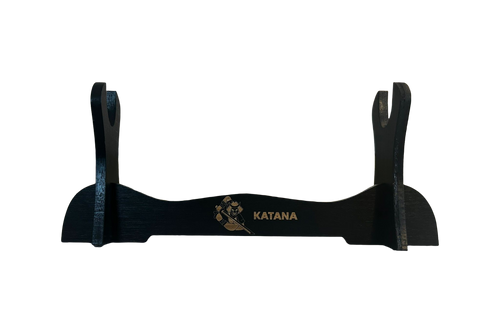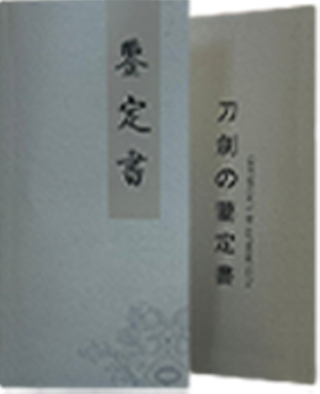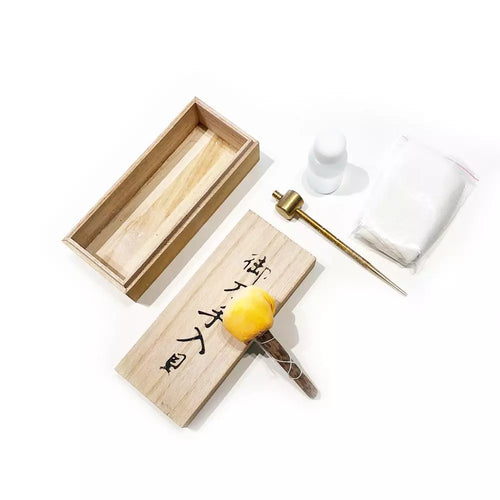| A |
-
ara-nie: Large nie crystals.
-
ashi: Thin line that runs across the temper line (hamon) to the cutting edge (ha).
-
ayasugi-hada: Regular wavy surface grain pattern (jihada).
|
| B |
-
bakumatsu-to: A sword made during an era in the late Edo period 1853-1867.
-
bizen: Archaic province of Japan, modern-day Okayama prefecture.
-
bokuto: See bokken.
-
boshi: Temper line (hamon) of the blade point (kissaki).
-
bu: Japanese imperial form of measurement.
|
| C |
-
chikei: Black gleaming lines of nie that appear in the ji.
-
chirimen-hada: Distinctly visible mokume-hada with a clearer steel than in similar but coarser patterns.
-
choji abura: Clove oil, used for preserving blades.
-
choji midare: An irregular hamon pattern resembling cloves, with a round upper part and a narrow constricted lower part.
-
chokuto: A straight sword primarily produced during the ancient period.
|
| D |
-
daisho: In context any pair of Japanese swords of differing lengths (daito and shoto) worn together.
-
dogane: Tubular fittings on the tsuka or saya.
-
daito: Any type of Japanese long sword, the larger in a pair of daisho.
|
| F |
-
fuchigane: Decorative reinforcing collar attached to the base of the tsuka.
-
fukura: The cutting edge (ha) of the blade point (kissaki).
-
funbari: Tapering of the blade from the base (machi) to the point (kissaki).
|
| G |
-
gassan-hada: See ayasugi-hada.
-
gendaito: Swords produced after 1876.
-
goban kaji: Swordsmiths summoned by the retired Emperor Go-Toba to work at his palace in monthly rotations.
|
| H |
-
ha: The tempered cutting edge of a blade.
-
habaki: Small metal collar that buffers the tsuba and secures the blade into the saya.
-
habaki-moto: Part of the blade that sits under the habaki.
|
| I |
-
ichimai boshi: A fully tempered point area (kissaki) because the hamon turns back before reaching the point.
-
ichimonji kaeri: A boshi which turns back in a straight horizontal line with a short kaeri.
-
ikubi-kissaki: A short, stubby blade point (kissaki).
|
| J |
-
ji: Area between the ridge (shinogi) and the hamon.
-
jigane: Generally used to refer to the material of the blade.
-
jihada: Visible surface pattern of the steel resulting from hammering and folding during the construction.
|
| K |
-
kaeri: Part of the temper line (hamon) that extends from the tip of the bōshi to the back edge (mune).
-
kaiken: A dagger concealed in the clothing.
-
kasane: Blade thickness measured across the back edge (mune).
|
| M |
-
machi: Notches that divide the blade proper from the tang.
-
masame-hada: Straight surface grain pattern (jihada).
-
matsukawa-hada: Surface grain pattern (jihada) resembling the bark of a pine tree.
|
| N |
-
nagakatana: Any sword with a blade longer than a tanto.
-
nagamaki: Large sword with a usually katana-sized blade and a very long handle of about equal length.
-
naginata: Pole weapon wielded in large sweeping strokes.
|
| S |
-
sageo: Cord attached to the kurikata to help secure the sword in the belt.
-
sakihaba: Blade width (mihaba) at the yokote.
-
sakikasane: Blade thickness (kasane) at the yokote.
|
| T |
-
tachi: Curved sword with a blade length longer than 60 cm.
-
tamahagane: Japanese steel, used for the manufacture of Japanese swords.
-
tsuka: Handle of a Japanese sword.
|
| U |
-
uchigatana: A Japanese sword worn edge-up in the obi.
|
| W |
-
wakizashi: A short sword, often worn together with a katana as the daisho.
|
| Y |
-
yakiba: The hardened edge of the blade, formed by the hamon.
-
yakidashi: The area of the blade where the hardened edge (yakiba) begins.
-
yakidashi: The notch at the habaki-moto where the hardened edge (yakiba) starts.
-
yari: A Japanese spear.
-
yasurime: File marks on the tang.
-
yokote: Line that separates the tip area (kissaki) from the rest of the blade.
|
| Z |
-
zanmai: Blade-forging technique involving a mixture of tamahagane from several different layers of tatara.
|



